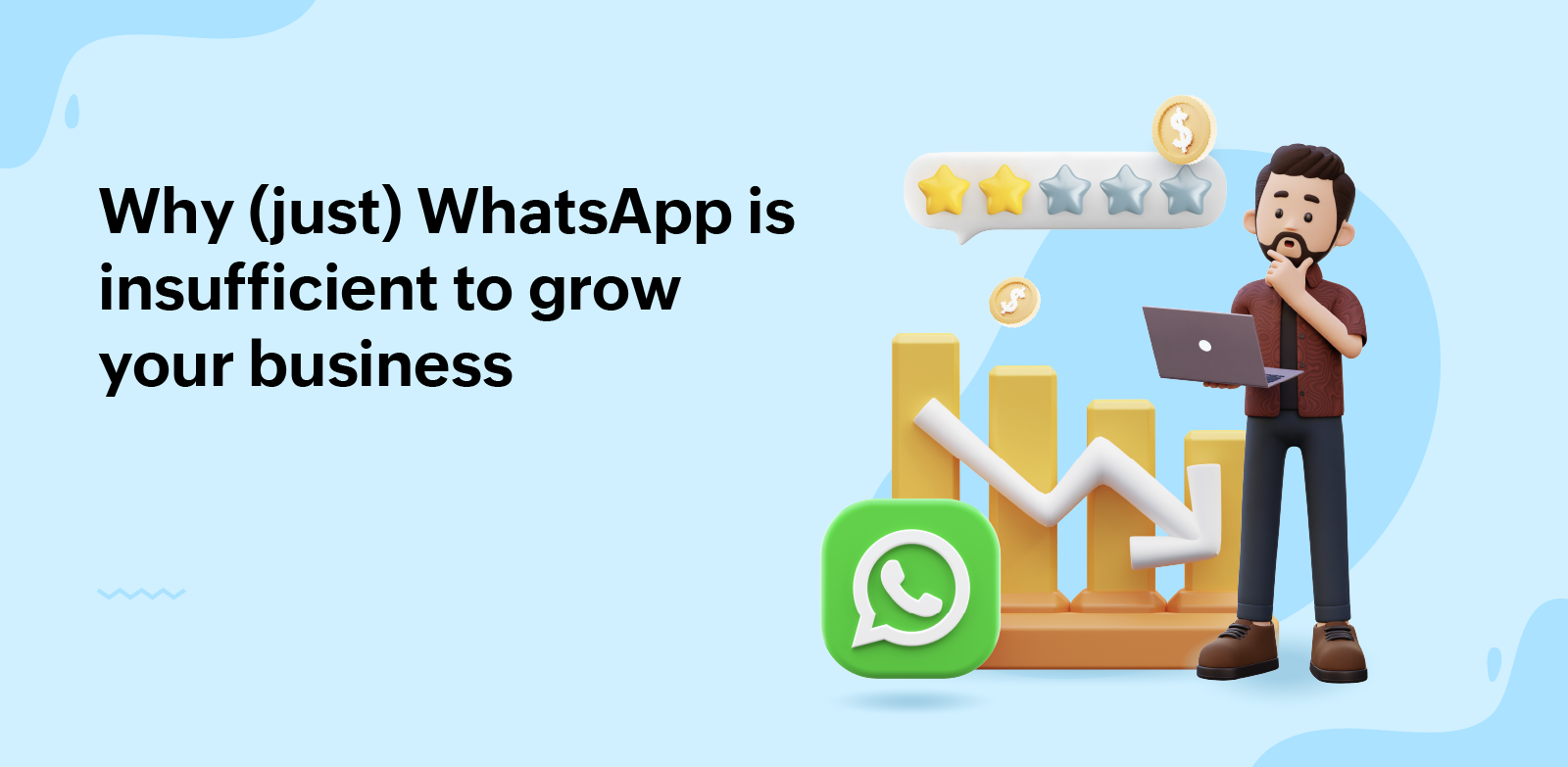- HOME
- Thought leadership
- Why (just) WhatsApp is insufficient to grow your business
Why (just) WhatsApp is insufficient to grow your business
- Published : March 20, 2025
- Last Updated : March 20, 2025
- 266 Views
- 9 Min Read

Sarah runs a small but popular bakery in a bustling neighborhood. Her freshly baked products have gained a quite fan base. She started taking orders through WhatsApp, thinking it would be the easiest way to manage customer conversations. And it was simple; she uploaded her menu, people checked and inquired, she responded, and the orders kept coming.
As her business grew, so did her team. She now has four employees. Two help her in the kitchen, and the other two handle sales and deliveries for both in-store and online orders.
Soon, Sarah opened a second location, bringing in an additional team of five to manage operations there. For a while, everything ran smoothly, and WhatsApp felt like the perfect solution.
But as her team expanded and her customer base continued to grow, managing her business only through WhatsApp became overwhelming. Her team is now facing multiple issues.
First and most important, their communication process is messy. There's no collaboration, and they spend a lot of time keeping up with different chats and notifications. Managing customer group chats, team chats, and person-to-person chats is getting pretty confusing for them. Because of that, mistakes happen all the time.
One time, a birthday cake order got mixed up with a wedding cake as both customers had the same initials, and they ended up delivering the wrong cake to both customers. Another time, an order was completely missed because it got buried under a flood of New Year messages in the group. This led to a frustrated customer and a bad review for the business.
They often have missed messages, delayed responses, and unhappy customers—all of which impact the business growth and reputation. Now, Sarah's starting to realize that what once used to work fine is now slowing her business down.
WhatsApp bottlenecks for Sarah's business
Sarah’s team handles customer orders, responds to inquiries, and coordinates deliveries—all through WhatsApp, but relying only on WhatsApp is now holding them back instead of helping them grow. Here’s why.
Team collaboration is tough
Team collaboration in WhatsApp is challenging because there's no clear workflow and no defined roles for team members. Every team member can send messages or replies, which is sometimes confusing for everyone.
All customer messages land in the same place, and there's no way to assign them to specific team members. That means you can't really decide who's handling what, which leads to confusion and sometimes even duplicated responses.On top of that, there's no dedicated space for internal team discussions. If your team needs to discuss something, it can only happen in separate chats. It just increases the chances of things getting lost and misunderstood.
For Sarah, keeping everyone on the same page is a constant headache. She has to rely on personal or group chats to share updates and instructions. It's always unclear, and there's confusion among her team about who's supposed to respond to what. Did someone miss a customer’s message? Who's handling that follow-up? It's tough to keep track of everything.
Managing multiple conversations isn't easy
WhatsApp doesn't allow you to categorize and sort messages properly. Also, it has limited filter options, so it's difficult to find specific messages from your past conversations. Additionally, the sorting options aren't tailored for team workflows, which makes it hard to manage different types of messages that you may receive for your business. Even though you can label messages, those labels are for personal view. Your team members can't see the labeled messages separately.
Sarah gets hundreds of messages on her WhatsApp every day. Some are new orders, some are about available flavors and delivery estimates, while others are following up on previous orders. It's not easy to categorize these messages or filter the important ones. WhatsApp doesn't allow Sarah and her team to filter all order-related conversations exactly because customer details and new orders are getting lost amidst this flood of messages.
A regular customer, Emma, orders cakes monthly, but Sarah doesn’t have an easy way to pull up past orders to personalize her experience. This means Emma gets the same standard service every time instead of a personalized touch that could make her feel more valued.
Limited communication channels
Sure, WhatsApp is easy to use, but not everyone shops here. A lot of customers prefer social media messaging, such as Instagram DM or Facebook Messenger, to place orders. They like checking out reviews, ratings, and seeing what other people say before they buy anything. Plus, these apps allow you for more personalized and targeted marketing.
Sarah is actively using social media platforms such as Facebook and Instagram to promote her business. But managing customers' messages from these channels is time-consuming for her. Instagram DMs or messages from Facebook messenger won't land in her WhatsApp account. She has to continuously check these apps for new queries or orders. It’s exhausting, and it takes time away from baking and focusing more on other important tasks.
There's no automation tools to save time
WhatsApp lacks advanced automation, such as setting workflow rules, auto-assigning conversations to a particular team member, or automatically moving messages from one group to another. Doing everything manually consumes a lot of time for everyone, and the chances of errors are always there.
This is exactly what Sarah's team is dealing with. They're juggling order updates, payments, design and flavor customizations, and deliveries. Different team members handle each task. Whenever a new message comes in, it doesn’t automatically go to the right person. Instead, Sarah either has to forward it or wait for someone to check and respond. This back-and-forth eats up their valuable time, slows down their workflow, and increases the chances of mistakes.
There's no easy way to connect with other productivity apps
Running a business and managing customer conversations usually requires pulling data from other apps, such as CRM or project management apps. But in WhatsApp, integrating third-party apps isn't so simple. Because of its API policies, businesses need API access, which makes direct app integrations more complex for them.
For Sarah, a CRM app would be a great help. She can use it to help her track customer orders, preferences, and interactions, making it easier to manage repeat customers, ensuring that no detail is missed. A project management platform can also help her with ingredient inventory tracking and task assignments. It would ensure that the bakers and delivery staff always stay on the same page. But right now Sarah’s stuck relying only on WhatsApp for everything, which makes the business process a lot more complex for her.
Only limited analytics are available
WhatsApp has only basic analytics on the number of messages sent, delivered, received, and read. It doesn't give you detailed analytics of your business and teams. But when you're running a business, you need much more than that. You need real insights into how your team is performing.
Customer communication is an important aspect of businesses like Sarah's. She needs to know if her team is responding to customers quickly and efficiently. Are messages being answered on time, or are customers waiting too long for a reply? How is an individual member handling their part of communication? Is there any delay in replies? Without these parameters, she can't really see how her team is communicating with customers, which is crucial for the growth of her business.
Sarah needs a platform that gives her clear communication, a structured workflow, and better control over things to keep her business growing.
The smarter alternative: a multichannel shared inbox platform
After realizing the limitations of WhatsApp, Sarah decided to switch to Zoho TeamInbox, where her entire team could work together seamlessly and her business runs without any hiccups. Zoho TeamInbox offers her a multichannel shared inbox platform that's designed to enhance team collaboration and bring transparency to the communication process. It allows her to communicate across all channels from a single centralized place and manage things more efficiently.
In her inbox, Sarah can connect not only her business WhatsApp but also her Facebook Messenger, Instagram DMs, and email channels, all in one place. It's a much more organized way to manage communication without any mess.
Additionally, Zoho TeamInbox offers other advanced features, such as shared email templates, setting up response time goals, custom views, and antispam to help keep her communication process hassle-free.
With Zoho TeamInbox Sarah now has everything she needs to run her business, which we'll discuss below.
Multichannel shared inboxes for her teams
Now, Sarah can bring multiple communication channels into a single shared inbox, making it easy for her team to collaborate without constantly switching between apps or windows. Let's say a customer places an order through Facebook Messenger or sends a message via Instagram DM. It will automatically land in her team's shared inbox. This means her team can easily see and respond to all these messages from one place, ensuring faster replies and a smoother customer experience.
Clear role and permissions for team members
Sarah can now streamline her communication process by creating separate inboxes for her team, such as inboxes for customer orders, supplier communications, and delivery tracking. There, she can assign roles and permissions to her team members, so that each of them has a different level of access within their inboxes. This will help them focus only on the messages that matter to them and avoid distractions from unrelated conversations.
A global view of all conversations
Sarah's TeamInbox gives her a clear, organized view of all conversations across multiple channels, including those assigned to her or other team members, as well as conversations she’s following, snoozed messages, and unread threads. This global view of all conversations is accessible by her entire team to ensure transparency and prevent missed inquiries or duplicate responses.
Space for internal team conversations
Sarah's teams can easily collaborate within their inboxes through internal discussions and comments. They can easily discuss customer issues, coordinate details about a new order, or change delivery schedules without having to jump to other places. This brings transparency to communication, reduces confusion, and helps the team respond faster and more accurately.
Shared tags for better categorization of threads
For Sarah's team, organizing customer orders and messages wasn't easy when each team member was using their own tags to label the threads. Individual labels aren't visible to other members in the WhatsApp group. Shared tags solve this problem by allowing the entire team to use different tags for organizing messages. When one team member adds a shared tag to a thread, it becomes visible and accessible to the whole team.
This makes it easier for Sarah and her team to find important messages such as urgent orders, inventory related messages, and work on them faster.
Automations and better analytics
Sarah can now automate multiple repetitive tasks, such as archiving messages, assigning threads to team members, moving threads from one inbox to another, and much more, by creating automation rules. This not only saves her team valuable time but also ensures smoother operations without any errors. Sarah also has a detailed analytics report to track individual team members' performance and response times more effectively.
Multiple app integrations
Zoho TeamInbox has integration options with various pre-installed Zoho applications as well as external applications. This helps Sarah streamline multiple aspects of her bakery business. For example, with Zoho CRM, she can properly manage her customer database, track individual flavor preferences, set up reminders for customers' birthdays and anniversaries, and keep her inventory and order management processes organized. This way, Sarah ensures that her customers receive a more personalized experience while keeping her backend operations smooth and hassle-free.
Wrapping up
By switching to Zoho TeamInbox, Sarah and her team can manage all of their communications in one centralized place. Now there's no more juggling between apps or digging through endless chat threads. All conversations from different channels are in the right place, ensuring that no message is lost or forgotten.
They can discuss internal matters within the app itself, keeping everyone on the same page without confusing separate chats or scattered group messages. Automation rules take care of assigning tasks, organizing conversations, and making sure the right team member responds at the right time, keeping everything organized and streamlined.
With smoother team collaboration, clear communication, and faster response times, Sarah’s team works better than ever. They can focus more on what they do best, bake amazing treats, and delight their customers without any unnecessary stress.
Now Sarah has finally said goodbye to the chaos and spends more time on growing her business, creating new recipes, and giving her customers the best experience every time.
The result? A happier team, happier customers, and a business that’s ready to scale.


